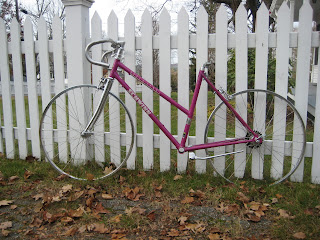This is a weekend I normally wouldn't have had the girls. But Ava had a play date today, so their mother asked me to take Juli for a few hours. Yay! In addition to doing a few chores, we spent about an hour on Juli's Schwinn, taking off the parts I'd test-fit, washing and waxing the frame and fork, and starting the bike's build, for real. We have a long way to go, as you can see, and the process will likely be broken into several sessions, but the build should go quickly.
In anticipation of this, I'd moved my bike stand back up into the attic, along with my bike tools, the Schwinn itself, and Juli's old Fuji, which will serve as a donor bike. What doesn't get donated to the Schwinn from that bike will come off and go into a box, so that I can ultimately send that frameset out for a strip and repaint on Ava's behalf before its next build-up. If I'm completely off my rocker when the time comes, I may also get shift cable stops and a pair of bottle cage braze-ons installed in the process.
The big thing worth mentioning about the build so far is the headset, whose final state you can see here. As I mentioned last time, we're using a threadless headset with a top nut from a threaded headset, a NOS Suntour locknut to keep the top nut in place, a stack of 1" headset spacers, a 1" threadless cable hanger, and a Nitto 50mm quill stem. The steerer tube is long, and it has only a couple of inches of threading. On this frame that's not enough to allow the use of a threaded headset, and too much to allow for a threadless headset, cable hanger and stem, if the threaded part were hacked off. So this mash-up was cobbled together, and it seems to be working just fine, in that the fork turns and nothing seems to be doing anything untoward. I'll let you know how it holds up in service. We did rearrange the stacked parts, relative to the test-fit, to get the stop a little lower than it was. The handlebars are old French bars -- nice and compact for their intended user. One thing I noticed is that the handlebar collides with the top tube at full lock. The bike will have bar-end shifters, but I might twine and shellack that spot on the top tube, both to protect it and to cover the blighted paint that's in that spot today (apparently this isn't new to the current bar and stem combo).
The Greenfield kickstand is bolted into place, and I'm hoping the frame's kickstand plate will keep it from moving around down there (I remember these things drifting around when I was a kid). I might also twine and shellack the kickstand arm to protect the crankset. Might. We'll almost certainly have to trim and file that arm once we have tubes and tires installed on the wheels, to get the right lean.
Speaking of tires, once the bike is on its rolling stock, we can level the saddle and handlebar, and also figure out how much to trim the Pletscher struts so the rack sits level to the ground when installed on this little frame. I suppose we could do that without tires, too, but I don't like setting a bike on the ground on bare rims.
We installed the crankset, which is the same one that served Juli well on the Fuji, as well as the saddle and one bottle cage from that bike. The crankset is a 165mm Bontrager part with compact rings (36/50 iirc), and it mates to a Truvativ ISIS bottom bracket. The saddle is a Brooks B17, in honey. And the bottle cage is just a Specialized cheapie. Other components and accessories will make their way over from the Fuji in later sessions, including the rest of the drivetrain, the control levers, another cage on an auxiliary mount, a bell, a saddle bag and a blinky.
I also ordered most of the last of what we'll need, today. During the work we did today, I noticed a few more things we'll have to install, but even so, the list is short: tires & tubes, a cable stop for the seat tube, brake pads, a pair of barrel adjusters, a chain, and a plastic cable guide for under the bottom bracket. I couldn't get that last part from Rivendell, so I'm going to hit my LBS for that sometime in the next week or so. The rest should be here after Thanskgiving.
Anyway, Juli seemed to have fun, and she seems fully over the pinkness of it all, now that the bike is coming together. She greased the headset races, installed the rear brake and water bottle cage, washed the frame, and seemed enjoy stroking the freshly waxed paint and chrome. Don't we all, though?
All for now,
J







